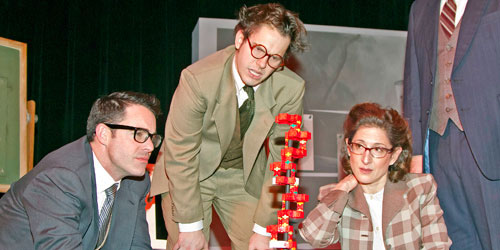By John Quinn

Andrew Parker, Pete Podolski, Carol Lempert, and Brian P. Sage in The Jewish Ensemble Theatre Company's production of "Photograph 51." Photo: Jan Cartwright
As a biology student at U-M, I found the names "Watson and Crick" paired like Laurel and Hardy or cookies and cream. Molecular biologist James Watson's tell-all memoir, "The Double Helix: A Personal Account of the Discovery of the Structure of DNA," had just been published. The determination of the "secret of life" was already considered one of the great scientific achievements of the 20th century. The sweet smell of success wafting from the 1962 Nobel Prize in Physiology or Medicine, which Watson shared with colleague Francis Crick, and with Maurice Wilkens of King's College, London, stimulated the imaginations of the entire Biology Department.
The name buried in footnotes was that of Dr. Rosalind Franklin, biophysicist and X-ray crystallographer, who was Wilkens' collaborator. That historical oversight is the subject of "Photograph 51," the provocative work of playwright Anna Ziegler. It demonstrates that interpersonal relations can be as twisted as a double helix. "Photograph 51" is playing at the Jewish Ensemble Theatre in West Bloomfield.
Ziegler is forthright: She has "… altered timelines, fact and events, and recreated characters for dramatic purposes." What might have been a pedantic, historical review is instead a funny/sad tale of human foibles, full of colorful characters, and graced with an elegant plot.
Down to the brass tacks: It's London, 1952. Maurice Wilkens (Brian Sage) has coaxed Dr. Franklin to join in his research for the crystalline structure of DNA, using what may have been misleading promises. He and his research assistant, Ray Gosling (Keith Kalinowski), have made remarkable progress in X-ray diffraction analysis of the DNA molecule. He hopes that her expertise in X-ray photography will provide the clear pictures necessary to interpret the images in three dimensions. The collaboration is rocky. The independent and somewhat prickly Rosalind is the victim of the low regard for women in science and a smarmy anti-Semitism prevalent in postwar England.
Rosalind succeeds – the image nicknamed "Photograph 51" demonstrates that DNA forms a helix, but she hides the finding from Wilkens. Gosling passes the photo to Wilkens, who shares the discovery with a couple of cronies at Cambridge, the aforementioned Watson (Pete Podolski) and Crick (Andrew Parker). An "undeclared race" is on to be the first to crack the code; Rosalind is an unwitting participant.
"Photograph 51" is a multi-layered, multi-themed piece. It is in the form of "chamber theater;" all characters remain onstage for pretty much the whole show, narrating and commentating on scenes in which they don't participate. In so doing, they frequently speak directly to the audience. The technique is instrumental in turning the clinical setting into a more humanistic approach.
The dialogue is pretty dense. Nucleotides and nucleobases, purines and pyrimidines, all fall trippingly off the tongues of the good doctors, but don't resonate with mere mortals. It's best to ignore the geek speak; we're here for the personalities, not the science. But a couple of facts need explaining before the audience catches Ziegler's most profound metaphor.
Think of the DNA model as a ladder, on which the rungs are composed of two molecules – nucleobases. There are four of them, designated by their initial letters: A, T, G,C. Two of them are purines, two are pyrimidines. Opposites attract. But A goes looking for T and G looks for C – they form "complementary" bonds. Other pairings are unsuccessful mismatches. That, in a nutshell – albeit a convoluted one – is the theme of "Photograph 51." Watson and Crick was a successful match. Wilkens, conflicted by prejudice and unrequited love, and Franklin, guarded and socially unskilled, never "bonded."
Under the direction of David Magidson, JET's artistic director, "Photograph 51" is tight and stylish. Much of the humor derives from Kalinowski's take on Gosling – who, low in the food chain, can make wry comment on his "betters." Not to be outdone, an energetic Podolski plays mad scientist in comic contrast to Parker's more restrained Crick.
Sage's Wilkins may be the play's most complex character. Definitely he's a creature of social habit and professional bigotry, yet we can grieve with him that the unexpressed love triangle with Rosalind and her protege, Don Caspar (Russ Schwartz), doesn't end in happiness for either man. But the focus is Rosalind, and in Carol Lempert Magidson finds an actor who can make us forgive her thorny side and find, not sympathy for, but solidarity with, a forceful woman battling for respect.
Ziegler chooses to reveal the sordid underbelly of scientific research, and it's still with us. That hasn't changed since the '50s, even if women are now allowed in the physics building at Harvard – they weren't then. It helps to be reminded that the ivory tower has a dingy tint, and idols, cultural or scientific, have feet of clay.
REVIEW:
'Photograph 51'
The Jewish Ensemble Theatre Company at Aaron DeRoy Theatre on the campus of the Jewish Community Center, 6600 W. Maple Road., West Bloomfield. Wednesday, Thursday, Saturday and Sunday through Feb. 10. 1 hour 40 minutes. $38-$45. 248-788-2900. http://www.jettheatre.org










